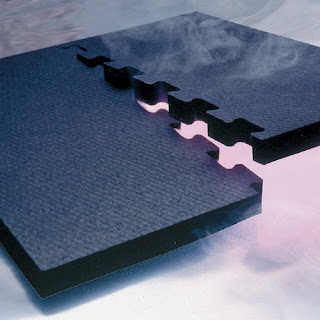Foam exercise gym floor mats can turn an arduous exercise regimen into a fun and exhilarating experience. Our foam mats add comfort to any space and can help reduce fatigue and injury. They can also add color and style to your exercise area, putting you in the mood to work up a sweat.
With so many foam mat options, it’s important to consider the differences between the product offerings. The most popular mats for exercise come in either puzzle tile or roll out mat forms. You'll want to consider what form of exercises will be performing before choosing an exercise mat.
Below are the top five most popular foam exercise gym floor mat options
1. Home Sport and Play Mat
Home Sport and Play Mats are 2x2 foot squares with puzzle style interlocking edges. They are made of 7/8 thick closed-cell EVA Foam. These durable puzzle mats feature a thatch surface that can stand up to athletic shoes. They are also waterproof and are reversible with a different color on each side. Use these puzzle mats to make a solid color floor; alternate two of the six tile colors for a checkerboard look; or create a pattern all your own. Use Home Sport and Play mats for Kickboxing, Aerobics, Home Gyms, Taekwondo and more. These soft foam mats are perfect for use over a cold, hard, concrete basement floor.
 |
| floor mats exercise |
2. Foam Floor Mats 5/8 Premium
For a similar, but more economical exercise gym floor mat option, take a look at Greatmats Foam Floor Mats 5/8 Premium mats. The difference between these puzzle mats and the Home Sport and Play Mats is that these are slightly thinner and are not reversible, but both mats are made with the same high-quality materials. These are especially popular for softening kids playroom floors as they are available in 15 different colors and are stain resistant.
 |
| exercise floor |
Foam Floor Mats 5/8 Premium mats are excellent for aerobic or floor-based exercises with low levels of impact. These puzzle mats have a universal interlocking design, allowing for the tiles to be connected together in any direction. For these foam mats all four side are the same, which isn’t a property of every interlocking mat.
3. Gmats Roll Out Mats
If your exercise regimen involves more intense activity, such as combat sports or wrestling, you'll want to check into roll out mats. A convenient 5x10 ft size, Gmats Roll Out Mats are designed home use. They are 1.25 inches thick and offer better impact absorption than the thinner previously-mentioned puzzle mats. The mats include a resilient tatami-textured vinyl top surface that can withstand the demands of wrestling and grappling workouts, as well as workouts that include shoes and boots. Multiple mats can be connected together with vinyl tape.
 |
| exercise floor mats |
4. Gmats Cheer Mats
Similar in design to the roll out mats are Gmats Cheer Mats which feature the same roll out design in a 5x10 foot size. At a slightly thicker 1 3/8 inch, these exercise made have a carpet-bonded surface as opposed to vinyl. The carpet surface offers more rebound and makes it great for stunting type exercises such as gymnastics, tumbling, and cheerleading. These cheer mats can be combined used connection strips.
 |
| foam exercise gym floor mats |
5. Pebble Top Foam Gym Floor Tile
These Pebble Top Foam Gym Floor Tiles are made with a high-density EVA foam that can handle the weight of exercise equipment, making them perfect for home gyms and weight room flooring. The reversible puzzle mats are 2x2 feet in size and 3/4 inch thick. These tiles offer a non-slip pebble-textured surface and a universal interlocking design. As these foam gym floor tiles are much denser that other foam flooring, it won’t indent as easily under heavy equipment.
While there are many different forms of foam exercise mats, these five should give a you a good start in knowing what to look for to meet your exercise room needs.
 |
| gym foam mats |













